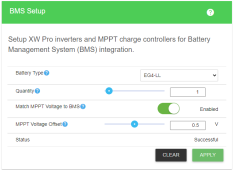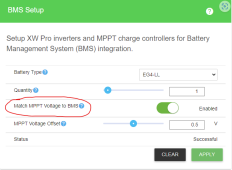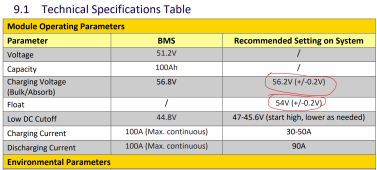In reply to 400bird...
- Schneider needs to update the MPPT to actually be smart in the system and communicate properly.
- Nowhere in the documentation is there an explanation that with LIPO4 batteries the sensor should not be used! And their tech support people say it should be used!
- I had tried 0 for the temp. compensation and then the MPPT stopped producing output entirely! I found this strange but figured that 0 must be considered an illegal value, so I tried low values like -5 instead of the default -108... that too did not work as it fed only about .5 Kw to the DC bus.
Like I said, it is incredible that on top of poor software and documentation, Schneider does not train their support techs. One would think that they would have a section in their training that would include those "fancy new batteries called LIPO4"!
The following is from their release notes:
Release 120-240V Firmware 02.04.00 Build 0029
Released: 06 Feb 2023
Summary of Changes
Added IEEE1547-2018 and HECO SRD 2.0 2020 grid codes
Added SoC Based Enhanced Grid Support
Added Low SoC Hysteresis
Increased the LBCO setting range to 50Vdc
Improved frequency shift response time for AC Coupling
Improved BMS comms lost operation
Improved transitions to backup power for multi-unit systems to optimize load sharing
Known Issues:
Enhanced Grid Support in voltage control mode (SOC Control Disabled) has the following limitation:
- When MPPT in float and DC coupled PV production is less than the sell Amps, the battery voltage may dip and XW pro result in sell cycling. The workaround for this would be to set Absorption time to 8 hours, so that absorption timer doesn’t expire before end of the solar day.
Enhanced Grid Support with External BMS, SOC Control Enabled was added in this release but has the following limitation:
- The XW Pro output to AC is limited by the Max Discharge current of the BMS, even if available solar from the MPPT exceeds the BMS limit. Ensure the battery maximum discharge current is greater than the maximum MPPT output if using this feature.
My comments: First, the main feature of this inverter is that it is "Hybrid" ... yet the main feature that makes it hybrid does not work properly. Second, their workaround solutions listed above do not work.
In their manual, they claim that to enable enhanced grid support one should set the "Grid support Voltage" to 64 as though that is a magic switch to turn it on - that does not work either (it deep cycles the battery continuously)! My son was on their tech support call for 2 hours and in "guiding" him to set up the system for EGS. Their "guidance" did not work at all! It was only by my experimentation that I figured out what values for the many parameters would actually make the system work. So I wonder how much testing they actually do??
So in the end I have a system that works but at an incredible cost of time!







![DSCN4284[1].JPG](/data/attachments/157/157912-cf847d9d24ee766c43a8f22f278288c1.jpg)
![DSCN3729[1].JPG](/data/attachments/157/157913-2d12f0a9f7dd1cf1d2042c3ff073026d.jpg)
